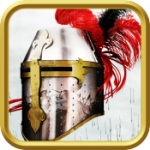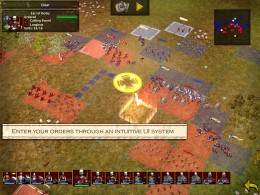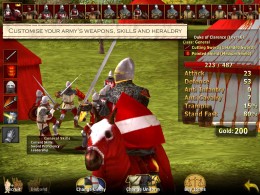 I’ve tinkered with a lot of real-time strategy games over the 30 or so years that I’ve been gaming. My relationship with the RTS genre has been a torturous one. It’s a genre that I have wanted to like more than I have actually enjoyed. Why that should be is complicated, but mostly it’s because I was intimidated by the complexity of the game style and the time investment needed to play RTS games effectively. Ironically, the complexity of the genre was also the reason I never lost interest in RTS games. Inevitably, some new RTS game would come along and capture my attention with siren calls of deep game play, complex strategies and detailed worlds.
I’ve tinkered with a lot of real-time strategy games over the 30 or so years that I’ve been gaming. My relationship with the RTS genre has been a torturous one. It’s a genre that I have wanted to like more than I have actually enjoyed. Why that should be is complicated, but mostly it’s because I was intimidated by the complexity of the game style and the time investment needed to play RTS games effectively. Ironically, the complexity of the genre was also the reason I never lost interest in RTS games. Inevitably, some new RTS game would come along and capture my attention with siren calls of deep game play, complex strategies and detailed worlds.
And so it is that I threw my hat into the RTS ring once again and began playing Great Battles Medieval ($9.99). After many, many hours of playing Great Battles: Medieval, I have come away with two primary impressions. First, this is a pretty good game but probably not the best the RTS field has to offer. Second, my torturous relationship with the RTS genre has diminished appreciably because of the many hours I had to spend with this game to write an appropriate review.
Great Battles Medieval takes place during the Hundred Years’ War, that epic century-plus long struggle between the French and English for domination of their shared geography. The game has two campaigns. The English campaign comes with the base game and a French campaign is available as an in-app purchase. A wafer-thin story told through grainy documentary style cutscenes advances the plot between each chapter of the main campaign. The story is thin and a mostly insignificant part of the experience.
The game is played from an overworld map representing France and England, and missions appear on the main map as you progress through the game. Some of the missions are part of a unified campaign and others are skirmish maps with preset goals. Occasionally, the enemy will launch an attack that you must complete to advance. There is also a skirmish mode if you want to avoid the campaign or jump in and start strategizing immediately. Once you select a mission you transition to a battlefield with a predetermined number and selection of units drawn from whatever forces you have managed to assemble.
This is a combat RTS, so there are no resources to gather and no buildings to construct. Your goal is to amass an army that can defeat anything the enemy throws at you. You begin with some basic units and a little money. As you complete missions, you earn money and experience to buy more troops and upgrade their attributes.
Combat starts out small with a couple of units on each side. Over time, you amass an army of hundreds of men made of up diverse units. Later in the game you gain access to better weapons, armor and equipment to assist you in your efforts. The game does a nice job of gradually ratcheting up the intensity and complexity of combat. From your humble beginnings with clubs and knives you’ll graduate to longbows, cavalry and artillery. It’s a lot of fun to improve your abilities and figure out the best way to position and utilize various units during combat.
 The game provides you with complete freedom to choose your tactics so there’s plenty of room for creativity. You can buy whatever units you want within your budget so you could focus on armored cavalry and try to trample through enemy units. On the other hand, the long bow was a game changer during the Hundred Years’ War so maybe you want to amass enough archers to rain death on your opponent. There are enough different kinds of units to accommodate all sorts of interesting combinations.
The game provides you with complete freedom to choose your tactics so there’s plenty of room for creativity. You can buy whatever units you want within your budget so you could focus on armored cavalry and try to trample through enemy units. On the other hand, the long bow was a game changer during the Hundred Years’ War so maybe you want to amass enough archers to rain death on your opponent. There are enough different kinds of units to accommodate all sorts of interesting combinations.
Once you’ve created your army, you have the added freedom of controlling their behavior, speed and direction during combat. The only strike against the game in terms of unit selection is that you can’t enter a scenario with the units you want. The AI selects your units for each scenario from the army that you’ve managed to amass at any given point. At times, it won’t matter because the game will start a scenario with all of your units. Sometimes, however, it chooses a smaller force for you.
The game has a pseudo turn-based feature that allows you to pause the action while issuing commands. The turn-based feature is a great way to control the action and manage the complexity of multiple unit movement.
Although Great Battles Medieval is primarily an RTS, it also has prominent RPG features that allow you to upgrade units, leaders and attributes. I’m a big role-playing fan so the RPG features were certainly the most familiar aspect of the game for me. As you fight battles, units gain experience that can be used to upgrade a variety of skills to improve attributes like combat, defense and leadership.
You can grind through some missions repeatedly to gain experience points and money. The downside to grinding is you have to engage in a lot of it to gain any appreciable experience or money. Also, you grind through the exact same missions over and over again, which robs the grinding of any spontaneity or variety.
The biggest criticism I have of the game is the utter lack of explanation for how just about everything works. If you have never played an RTS, I don’t see how you’re going to grasp the finer points of gameplay without many hours of frustrating confusion. The game has a brief tutorial that gets you started with the basics and then leaves you to your own devices. If you’ve played a lot of RTS games, you’ll probably have little trouble figuring out how things work, but if you haven’t played a lot of RTS games, you may be in trouble.
I know that it’s sometimes fun to experiment with gameplay and figure out how stuff works on your own. I have no problem with that approach as long as it’s implemented in a way that rewards experimentation. The problem with Great Battles Medieval is it does absolutely nothing to explain critical features that are unintuitive and buried so deeply in the game design that you barely notice them.
 For example, I kept losing the sixth battle in the English campaign. Unable to advance, and absolutely unclear about why, I lost interest in the game for a couple of weeks. After checking the TouchArcade forums for users familiar with the game, I learned that I could control a unit’s speed and combat behavior from the unit selection screen by tapping on two tiny diamond shaped icons. I had no idea you could do that and don’t know how I would have figured that out without resorting to the internet. The game really should come with some kind of in-game documentation to explain key features like unit control.
For example, I kept losing the sixth battle in the English campaign. Unable to advance, and absolutely unclear about why, I lost interest in the game for a couple of weeks. After checking the TouchArcade forums for users familiar with the game, I learned that I could control a unit’s speed and combat behavior from the unit selection screen by tapping on two tiny diamond shaped icons. I had no idea you could do that and don’t know how I would have figured that out without resorting to the internet. The game really should come with some kind of in-game documentation to explain key features like unit control.
Come on. How hard would it have been for the developer to put an in-game manual in the base camp? You spend a huge amount of game time in your base camp anyway buying equipment, purchasing units and upgrading skills.
A second issue I have with the game is the cumbersome control scheme. Selecting and controlling units is mostly easy: touch a unit to select it, touch where you want it to go and off it goes—kind of. Units go where you tell them to go unless you want to make adjustments on the fly. So if you want to change a unit’s command, you first have to cancel its initial order and then reassign it. Again, with no documentation or explanation, I just couldn’t figure out why some units wouldn’t do what I wanted until—once again—I visited the forums and learned that I had to cancel commands as a preface to issuing a new instruction.
My final issue with the game is the weird pathfinding. Units take some of the strangest routes when attacking opposing forces. It’s not exactly bad pathfinding, but I’m pretty sure armored cavalry wouldn’t charge straight at enemy pike-men, then ride around behind them before attacking, all the while exposing their flanks to danger. At other times a unit will choose a path through one enemy unit to reach another when it could just avoid the first group altogether. The game continually chooses odd paths to reach enemy units.
Graphically, the game is a mixed bag. The combat graphics and animations are pretty good. It’s exciting to zoom in on the action and see combatants battling it out at ground level. The combat animation is done well and everything looks colorful and detailed. The graphics on the main map and especially in the camp screens, however, are just smeared, blurry and ugly.
Great Battles Medieval has some optional IAP that you can avoid if you want. You can buy some in-game currency for a reasonable price if you want to avoid mission grinding to earn money. A couple of exotic units are available for a buck, and the French campaign is offered for five dollars. The game is complete without the IAP in the sense that you’re never forced to make a purchase to continue playing.
In the end, Great Battles Medieval is a pretty good RTS/RPG hybrid that gets enough right to merit your attention whether you’re a fan of the genre or new to the style. It’s not perfect, but it’s still fun in a lot of key areas. It helped me get over my resistance to the genre. For that reason alone, if no other, it’s a game that I would recommend with the criticisms expressed within.


